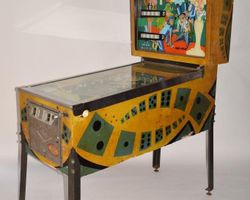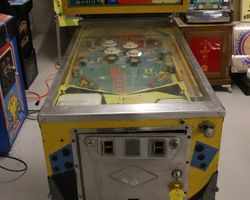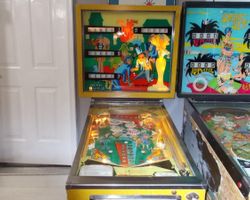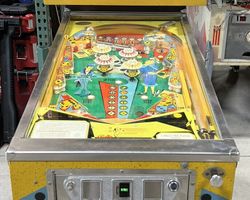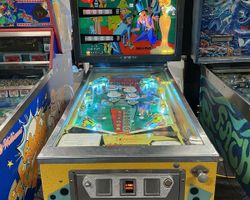Little Joe

Average Prices: USD $200 to $900
Produced: August, 1972
Production Run: 2,080 units
Machine Type: Electro-mechanical
Players: 4
Design by: Jim Patla
Art by: Christian Marche
"Little Joe," a pinball machine released by Bally Manufacturing Corporation in August 1972, emerged during a period when electro-mechanical (EM) technology defined the industry. Designed by Jim Patla with art by Christian Marche, this four-player game, bearing the model number 927, quickly distinguished itself within the Bally lineup. With 2,080 units produced, "Little Joe" became a notable entry in the EM era, renowned for its inventive playfield mechanics and a thematic approach rooted in the dice game of craps—specifically, the term "Little Joe," which refers to rolling two twos. The game's production run, while not massive, ensured its presence in arcades and family entertainment centers of the time, beginning its journey toward becoming a recognized example of Bally's design prowess.
Signature Features and Design
"Little Joe" stands out through a suite of distinctive features that were ahead of their time for an EM machine. Foremost among these is the innovative up-post positioned strategically between the flippers. This ball-saving mechanism can be raised by hitting specific targets, offering a temporary reprieve from an otherwise drained ball. Conversely, other shots may lower it, creating a dynamic interplay that demands player awareness. Another remarkable feature is the right-side ball return gate, an early precursor to the modern outlane kickback. When activated, this gate can redirect a ball from the outlane back into the shooter lane, providing an unexpected second chance. These two features alone significantly enhance gameplay, transforming potential drains into strategic opportunities and adding layers of depth rarely found in EM games of the period.
The playfield's aesthetic, crafted by Christian Marche, draws directly from the craps theme, presenting a visual narrative of the dice game. While the artwork is generally recognized for its distinctiveness and thematic relevance, sometimes described as having a "broke gambler" appeal, it also garnered mixed opinions, with some finding it "cartoonish" or, in the case of the cabinet, "butt ugly." Despite these varied perceptions, the integration of dice imagery and related elements throughout the playfield strongly reinforces the core gameplay mechanics, making the theme an integral part of the experience rather than mere ornamentation.
Playfield and Mechanics
The "Little Joe" playfield is a carefully constructed arena featuring two flippers, four pop bumpers, and critically, three mushroom bumpers. Two slingshots flank the flippers, while two standup targets offer distinct objectives. A kick-out hole adds another interactive element, and the aforementioned up-post between the flippers and two right-side ball return gates further define the layout.
The design philosophy behind "Little Joe" centers on constant change and strategic adaptation. The three mushroom bumpers are central to this. Each hit on these bumpers influences the value of one of the virtual dice displayed on the playfield, creating an ever-evolving objective. This dynamic interaction ensures that shots are not static; what was advantageous moments ago might now be less valuable, or vice versa. This encourages players to survey the playfield and adjust their shot selection based on the current dice combination, fostering a sense of immersion akin to playing a real dice game. The playfield's layout, while packed with features, is noted for feeling somewhat shorter than typical, particularly in its upper section, which can make hitting specific targets more challenging and demanding of precision. The artwork and lighting work in tandem to highlight these interactive elements, guiding the player's eye towards the critical areas where dice values are determined and scores are accumulated.
Gameplay Dynamics
"Little Joe" distinguishes itself with a rule set that is notably complex and strategic for an EM machine, often described as a "puzzle to solve." The gameplay revolves entirely around the concept of dice combinations, inspired by craps. Players do not accumulate a traditional end-of-ball bonus; instead, their primary objective is to manipulate the virtual dice on the playfield to achieve specific high-scoring combinations like a 7 or 11. Hitting the mushroom bumpers is the primary method for changing dice values, and players must strategically aim for these bumpers to set up desired outcomes.
The game encourages multiple skill shots, beginning with the plunger launch itself, which can be used to set up initial advantages. As the game progresses, precision becomes paramount in hitting specific standup targets or kick-out holes that may be lit for higher points or to activate features like the ball save post or the outlane return gate. Challenges include lighting the high-value shots and achieving extra balls, both of which require deliberate and skilled play. The upper gate, for instance, is rarely open and presents a difficult target when available. Despite the slower ball speeds inherent to EM machines, the constantly shifting objectives driven by the dice mechanics give "Little Joe" a fast-paced feel, demanding quick decision-making and precise execution. Balls can often last for extended periods, providing ample opportunity for players to explore the strategic depth.
Reception and Legacy
"Little Joe" garners overwhelmingly positive sentiment within the pinball community, frequently lauded as one of the standout EM machines, a "hidden gem," and a "player's game." Its innovative features, such as the pop-up ball save post and the early form of the outlane kickback, are consistently highlighted as being ahead of their time, contributing significantly to its unique appeal. Players often praise its deep and strategic rule set, which encourages thoughtful play and a dynamic shift in objectives rather than repetitive shot patterns. This strategic depth, combined with the fast-paced nature for an EM, contributes to its high replayability, keeping players engaged for countless games. The engaging dice theme and the distinctive artwork are also strong points, adding to the machine's overall allure. Its rules, while strategic, are accessible enough to introduce new players to pinball, making it a good "gateway" game.
Despite its many strengths, "Little Joe" is not without its minor criticisms. Its scarcity makes it a difficult machine to acquire for collectors. While the playfield artwork is generally well-received, some found it "cartoonish" or slightly mismatched in places, and the cabinet artwork specifically drew criticism from some as being "butt ugly." In competitive play, the outlane gate returning the ball to the plunger could occasionally cause confusion regarding whether an extra ball or ball save had been awarded. A few players noted the absence of a traditional bonus accumulation at the end of a ball, a feature common in other EM games. However, these points rarely diminish the machine's overall high regard.
"Little Joe" has cemented its legacy as a quintessential EM pinball machine, embodying Bally's innovative spirit of the early 1970s. Its pioneering features, particularly the dynamic ball save and outlane return, foreshadowed mechanisms that would become staples in later solid-state designs. More broadly, its complex, strategy-driven rule set demonstrated that EM games could offer more than just simple scoring, providing a "thinking man's table" experience that continues to resonate with enthusiasts who appreciate deeper gameplay. Its influence is less about direct imitation and more about proving the viability of innovative mechanics and strategic depth within the constraints of electro-mechanical technology, securing its place as a significant entry in pinball history.
Sponsored Links
 Ebay Listings
Ebay Listings
 Auction Results
Auction Results
| Cost | Location | Date |
|---|---|---|
| GBP £1,088 |  United Kingdom United Kingdom |
06 December, 2024 |
| USD $575 |  Pennsylvania, United States Pennsylvania, United States |
29 January, 2024 |
| USD $1,800 |  Georgia, United States Georgia, United States |
11 May, 2023 |
| USD $1,200 |  Ohio, United States Ohio, United States |
21 March, 2023 |
| USD $3,999 |  California, United States California, United States |
22 September, 2022 |
| USD $2,489 |  Florida, United States Florida, United States |
08 March, 2022 |
| EUR €955 |  Hessen, Germany Hessen, Germany |
28 April, 2021 |
| EUR €895 |  Hessen, Germany Hessen, Germany |
24 April, 2021 |
| USD $400 |  Arizona, United States Arizona, United States |
30 January, 2021 |
| EUR €950 |  Nordrhein-Westfalen, Germany Nordrhein-Westfalen, Germany |
21 December, 2019 |


Private Policy · Search Website · Contact Us
As an eBay Partner, we may earn a commission from qualifying purchases made through links on this site, at no additional cost to you.
All trademarks and copyrighted materials remain property of their respective owners. All other content copyright 2007 - 2025 Pinpedia.

